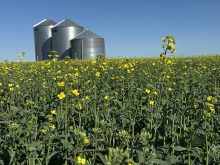Fed cattle move higher
The biggest news of the week was positive with the announcement that U.S. country-of-origin labelling will have flexibility.
Cattle can be commingled so there could likely be renewed interest from U.S. packers for Canadian slaughter cattle.
The Canfax average steer price last week was $87.35 per hundredweight, up $2.82 from the week before. The heifer average was $86.55, up $2.07. The Canadian dollar fell.
Even with higher fed prices, the basis widened to $17.16 under compared to $14.47 under the week before.
Read Also

Huge Black Sea flax crop to provide stiff competition
Russia and Kazakhstan harvested huge flax crops and will be providing stiff competition in China and the EU.
Close to 20,600 head sold.
Fed cattle exports totalled 10,047, down 36 percent from last year.
There will be sizable offerings over the next few weeks, Canfax said. The new COOL rules might improve U.S. interest. If it does not materialize, it might be hard for Canadian packers to keep the market steady.
D1, 2 slaughter cows fell 80 cents to $40 per cwt., due mostly to cold weather that hampered movement.
Butcher bulls fell 91 cents.
Cow volumes were expected to increase with improved weather and travel conditions. Seasonal bred cow sales will begin in the next two weeks, increasing volumes.
Breeding bull culling over the next two months will increase butcher numbers but steady demand should maintain cow and bull prices.
U.S. beef rises
A slowdown in U.S. slaughter helped cutouts rise dramatically with Choice up $7 US to $150.75 and Select up $6.86 to $143.62, said Canfax.
Choice cutouts are $3.73 higher than last year and Select cuts are $4.35 higher. But demand is not strong and traders were disappointed that beef prices did not rise more.
The Calgary wholesale market for delivery this week was $1 lower at $154 Cdn.
The Montreal market fell $2 to $167.
Byproducts held mostly steady with a range of $60-$95.
Feeders edge higher
Feeder cattle prices were generally $1 higher than the week before.
Volumes recovered as the weather improved, Canfax said.
Light 300-400 pound steer calves fell $1.88 per cwt., reflecting low quality and low volume.
Steers 400-500 lb. rose 39 cents and 500-700 lb. were up $1.31-$2.62 while 700-800 lb steers rose 69 cents. Heavy steers 800-900 lb. and heavier rose 26-33 cents.
Heifers 300-400 lb., jumped $5.04 higher while 400-500 lb. rose $1.79 and 500-900 lb. traded $1-$1.50 higher. Heifers 900 lb. and heavier fell by 97 cents.
Sales volumes soared 97 percent from the week before to 19,791 head. That was up 16 percent from last year, Canfax said.
Exports to the U.S. two weeks ago totalled 2,868 head. That was 69 percent lower than last year.
The final U.S. COOL rule takes effect March 15, but positive labelling revisions and anticipated record low third quarter cattle-on-feed placements in the U.S. will likely improve interest in Canadian feeder cattle.
Large numbers of fed cattle are starting to exit feedlots. With pen space available, demand for calves is improving.
Many grass farmers have also dispersed cow herds and have switched over to grazing feeders.
In the next week or two, expect early interest and increased competition for this year’s smaller supply of light to mid-weight grass-type stockers.
Although there is now little incentive to place feeders, anxious feedlots will be ready to bid when the race to procure feeders begins, Canfax said.
Cattle on feed
The number of cattle on feed in Alberta and Saskatchewan feedlots Jan. 1 was 1.034 million, up five percent from last year at the same time, said Canfax.
The total was down 2.6 percent compared to Dec. 1.
Placements in December dropped 18 percent to 121,043 head, due to cold weaher, tight pen space and low prices.
Marketings in December totalled 138,600, a two percent decline from last year at the same time.
Other disappearance totalled 11,029, an increase of 10 percent over last year.
Pork prices fall
Cold weather in the U.S. slowed hog deliveries. Pork prices fell, hurting packer margins.
Iowa-southern Minnesota cash hogs edged slightly higher to $45 US per cwt. Jan. 16 from $44 Jan. 9.
The U.S. pork carcass cut-out value fell to $56.60 Jan. 16 from $59.50 Jan. 9.
U.S. federal slaughter to Jan. 17 was estimated at 2.32 million, down from 2.39 million Jan. 10 and down 3.9 percent from last year.
Bison prices dip
The Canadian Bison Association said prices dipped last week by an average of five cents on bulls and heifers, but the market outlook is strong and steady.
Grade A carcasses from youthful bulls in the desirable weight range in Canada were $2.30-$2.70, with an estimated average of $2.40 per lb. hot hanging weight.
Heifers were $2.20-$2.60 per lb. with an average of $2.20.
The cull cow and bull average rose to $1.05 per lb., with sales to $1.30.
Weight, quality and delivery location affect final price.
The U.S. Department of Agriculture reported prices in that country in December were steady. Young bulls were $235-$245 US per cwt. and averaged $241.11. Young heifers were $205-$240 for an average of $226.38. Aged bulls averaged $150.70 and aged cows averaged $143.66.
Sheep, lambs stronger
Beaver Hill Auction in Tofield, Alta., reported 362 sheep and lambs and 13 goats traded Jan. 12.
Sheep and lambs were stronger and goats steady. Lambs lighter than 70 lb. were $130-$157 per cwt.
Lambs 70 to 85 lb. were $135-$154, 86 to 105 lb. were $135-$150, and those heavier than 105 lb. were $133-$140.
Rams were $50-$94 per cwt. Ewes were $50-$68.
Good kid goats were $150-$180. Nannies were $40-$80 per cwt. and mature billies were $100-$165.
Ontario Stockyards reported 1,803 sheep and lambs and 25 goats traded Jan. 12.
Lamb trade was active at lower prices. Good sheep were barely steady and thin types fell. Goats were steady.
















